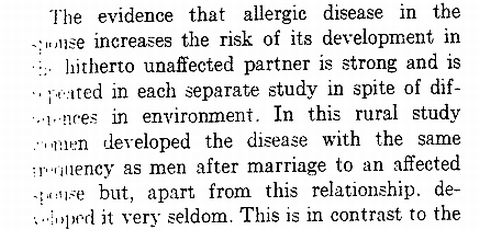A funny question answered in Allergy.
After adjustment for age, sex, parental predisposition and social status, the risk of hay fever was more than double in subjects who lived together with a partner having the same disease (odds ratio 2.4 […]). If subjects lived together with an affected partner, the risk of developing the disease increased with the time the partners lived together (1-11 years, OR 1; 12-23 years, OR 1.8; 24-35 years, OR 7.4; 36-54 years, OR 13.7).
Whatever that means – improved recall, shared doctor, non random mating, shared food, transmissible agent in descending order – it has been noticed already 40 years ago by Montgomery Smith and Lloyd Knowler in the Am Rev Resp Dis 1965; 92:16:

CC-BY-NC Science Surf
accessed 16.12.2025
